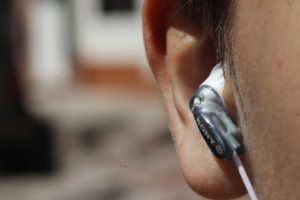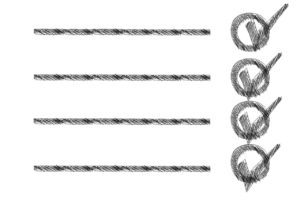 When you are writing for print, ideas and stories are communicated in a visual-linear mode which engages logic and thought. The kind of writing you do for a listener is quite different than when writing for readers.
When you are writing for print, ideas and stories are communicated in a visual-linear mode which engages logic and thought. The kind of writing you do for a listener is quite different than when writing for readers.
Writing for print addresses the intellect: the intent is to communicate an idea or present the facts and let the reader infer the meaning and significance of the words. When you write for the ear, you want to evoke an experience, a set of sensations in the listeners.
 There are times when authors are called upon to write for ears instead of the eyes of their readers. At author events, audiences are far more entertained by an engaging oral presentation than a long passage of a book read out loud. You’ve likely been to events when the author drones on in a monotone instead of an animated performance. If you are going to read directly from your book, keep it relatively short. Eight to ten minutes is best. Audiences are there to find out more about the author, the backstory to getting your book written and published, and mostly to be entertained. Since it’s your book, you may want to edit what you plan to read out loud for ears instead of eyes.
There are times when authors are called upon to write for ears instead of the eyes of their readers. At author events, audiences are far more entertained by an engaging oral presentation than a long passage of a book read out loud. You’ve likely been to events when the author drones on in a monotone instead of an animated performance. If you are going to read directly from your book, keep it relatively short. Eight to ten minutes is best. Audiences are there to find out more about the author, the backstory to getting your book written and published, and mostly to be entertained. Since it’s your book, you may want to edit what you plan to read out loud for ears instead of eyes.
There are other occasions authors write for the ear. Storytelling. Sermons. Lectures. Power-point presentations. Podcasts and radio segments. Poetry slams.
Making the switch from writing for print to writing for the ear isn’t all that difficult once you know some of the basic techniques.
 When writing for the ear, follow your ABCs. Accurate. Brief. Clear.
When writing for the ear, follow your ABCs. Accurate. Brief. Clear.
Be linear in your sentence constructions. Subject-verb-object. Avoid complicated structures with multiple clauses.
You can use more alliteration and repetition when writing for the ear than you can in print. Redundancy bores a reader, but can help the listener. In print it isn’t helpful to use three synonyms in a row to convey the meaning of something, but it might help when speaking to help the listener wrap their head around an important concept.
Avoid too many details. You still want to show, not tell, your audience. But too many details become noise and the listener doesn’t know what to pay attention to when listening. In print, this kind of precision creates a more three-dimensional world inside a reader’s head. When spoken out loud, too many details distract a listener from the heart of the story.
 Simplify the storyline for maximum impact. Consider what the major points are in your presentation and turn them into bullet points. Don’t fall in love with your words. Show your affection instead for the message.
Simplify the storyline for maximum impact. Consider what the major points are in your presentation and turn them into bullet points. Don’t fall in love with your words. Show your affection instead for the message.
Use numbers sparingly and give ballpark figures. About a thousand instead of 957. “Nearly half of people surveyed” instead of “48% of survey respondents.”
Use contractions. Didn’t. It’s. Wouldn’t. You’ll. “She will” works best for the eye, but “She’ll” is better for the ear.
Put the attribution tag before the quote. The listener wants to know who is speaking first and then what they said. Example: The mayor said “The city council will likely pass the measure.” When writing for print, the most important information comes first in what is said, followed by who said it. Example: “The city will heal,” said the mayor.
 Use short words. Most adults have a vocabulary of words they use every day of only 2,000 words. When writing for the ear, make what you say easy to comprehend. Listeners don’t have time to stop and look up a word in the dictionary. If you introduce specific terms or jargon, make sure their definition is crystal clear from the context.
Use short words. Most adults have a vocabulary of words they use every day of only 2,000 words. When writing for the ear, make what you say easy to comprehend. Listeners don’t have time to stop and look up a word in the dictionary. If you introduce specific terms or jargon, make sure their definition is crystal clear from the context.
Use short sentences. The dog retrieved the bone. The dog was a German shepherd. The dog received a head pat. Those three sentences would bore a reader and likely be condensed as follows: The German shepherd retrieved the bone and received a head pat.
If the words don’t roll easily off your tongue, replace them with words that do.
And the mother of all rules for writing for the ear, is practice, practice, practice reading it out loud. Eliminate all the filler words: ah, uhm, like, really, actually, very, and that.
 When writing for the ear, you want to use punctuation to indicate to the reader what expression to use. Periods. They. Really. Work. Pause for perfection in your delivery of the punch lines for full impact. Yes! A few exclamation points can help. Don’t end every sentence as though it were a question. Slow down. Even if you are nervous, or especially when you are nervous. Take a full breath between sentences. And please speak up! And look up at the audience from your pages and make eye contact. It creates intimacy in the connection between you and the listener that is comparable to the magic of reading print.
When writing for the ear, you want to use punctuation to indicate to the reader what expression to use. Periods. They. Really. Work. Pause for perfection in your delivery of the punch lines for full impact. Yes! A few exclamation points can help. Don’t end every sentence as though it were a question. Slow down. Even if you are nervous, or especially when you are nervous. Take a full breath between sentences. And please speak up! And look up at the audience from your pages and make eye contact. It creates intimacy in the connection between you and the listener that is comparable to the magic of reading print.
There are plenty of techniques used for writing intended for publication that also work best for oral performance. Use active voice, instead of passive. Develop your characters. Write in dialogue style. Focus on the action and moving the plot forward. Indicate to the reader when and where. Give them signals when you are using a flashback. Show, don’t tell. When nothing is happening, hurry it up. When there’s a lot of action, then provide the listener all the elements which transpire.

Writing for print has adopted some of the techniques used for the ear. My favorite is the convention of using em dashes — love this punctuation — to give a sense of how the mind and mouth work in reality. And incomplete sentences. Once consider taboo, they are now commonly used in print.
Whenever you write for an audience, consider what they need to comprehend what you are communicating.

I guess I’m always writing like my words will be read aloud. My bad. Thanks for explaining the difference here.
Great tips. I am on the verge of trying a story slam so your article was very timely and useful.
Love your insights and expertise, Jill. Just yesterday afternoon as I reread the day’s output I mused about incomplete sentences and dashes— and here you are addressing the topic. Thank you!
Thanks, Bett. It’s nice to hear.